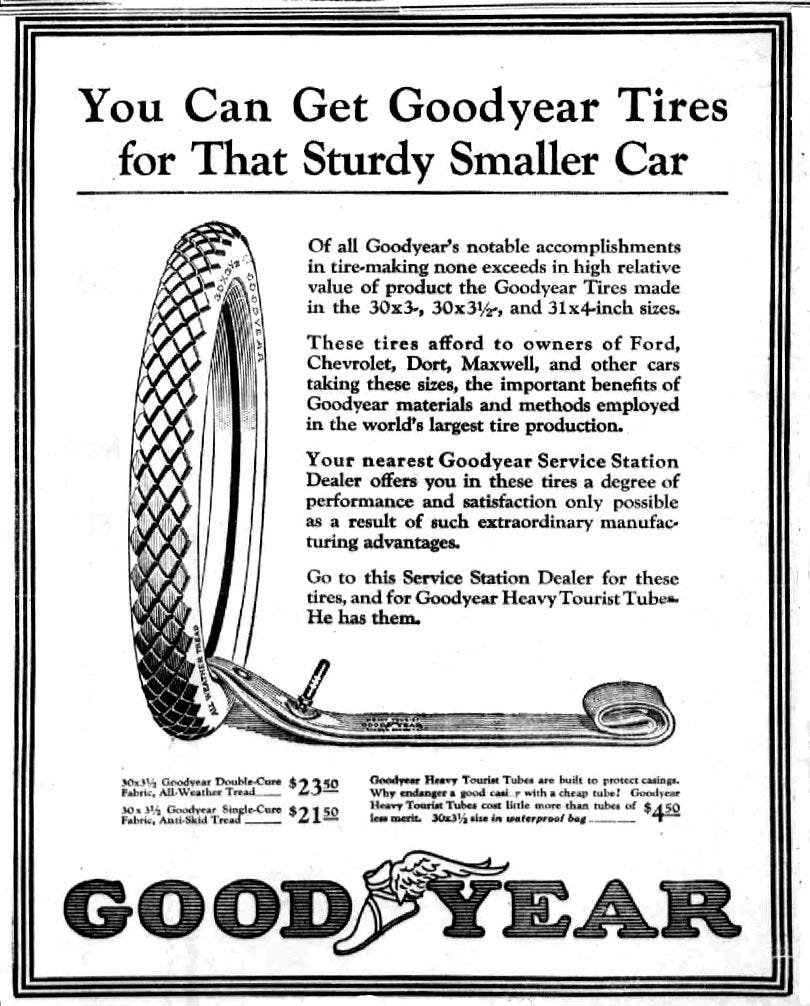Tire Abundance Has Been on a Roll Since 1920
Tires today are at least 1,000 times better than their 1920s precursors.
In 1920, you could buy a new Goodyear tire for your Ford, Chevrolet, Dort, or Maxwell for $21.50. A tube for the tire would add another $4.50. Unskilled workers at the time were earning about 29 cents an hour, putting the time price of the $26 combination at almost 90 hours.
Today, Walmart sells the Goodyear Reliant 195/60R15 88V All-Season Tire for $77. Unskilled workers today earn about $17.17 an hour, indicating a time price of 4.46 hours.
For the time it took to earn the money to buy a single tire in 1920, you could get 20 of them today.
Car tires today are also vastly superior to those manufactured in 1920 because of advancements in materials, design, and manufacturing.
Materials: In 1920, tires were made from natural rubber with cotton or fabric cords, prone to punctures and rapid wear. Modern tires use synthetic rubber, steel belts, and advanced compounds (e.g., silica) for better durability, grip, and fuel efficiency. Today’s tires last between 50,000 and 80,000 miles versus the 1,000 to 2,000 miles tires lasted in 1920.
Construction: Early tires were bias ply; their plies were arranged diagonally, with stiff sidewalls that limited handling and comfort. Radial tires, introduced in the 1940s and made standard by the 1970s, offer better traction, stability, and ride quality because of their flexible sidewalls and steel-reinforced treads.
Performance: Modern tires are engineered for specific conditions (e.g., all-season, winter, high-performance), with optimized tread patterns for grip, water dispersion, and noise reduction. Tires made in 1920 had basic treads, poor wet performance, and frequent blowouts at speeds above 30 to 40 miles per hour. Today’s tires can handle speeds above 100 miles per hour safely.
Safety: Tubeless tires, common since the 1950s, reduce blowout risks compared with 1920s tube-type tires. Many modern tires also feature puncture-resistant layers and run-flat technology, absent in 1920.
Manufacturing: Precision engineering and computer-aided design ensure consistent quality in modern tires, unlike the handmade, inconsistent tires of 1920.
Quantitatively, modern tires are 40 to 60 times more durable, support 3 to 4 times higher speeds, and provide 5 to 10 times better grip, based on historical tire performance data and industry standards. These improvements stem from decades of innovation driven by safety, performance, and efficiency demands.
Applying a conservative 50x multiplier for all these qualitative improvements to the 20x reduction in time price suggests that today’s car tires are at least 1,000 times better than their 1920 counterparts.
The next time you’re cruising down the interstate at 75 miles per hour, say a little prayer of gratitude for the relentless pursuit of better tires—driven by ingenuity, competition, and the quest for progress.




Gratitude is the essence of doomslaying.
Yes...........tyres are greatly improved ! As a child I can remember the many punctures that needed to be repaired ; and the 'tyre levers' , jacks and hand-operated-pumps that were standard equipment , along with patches and glue and chalk-powder to put over the excess glue on the patched-inner-tube so it didn't stick to the inside of the tyre when it was replaced ! Of course ,
there were the 'self-vulcanising-patches' that you could ignite and they would fuse a rubber patch onto the rubber tube ! Exciting stuff....adult-only-fireworks ! Even though Dad always carried a "spare tyre" on a rim for easy replacement , quite often there were 'blow outs' or
'staked tyres' as well that needed repairs or replacement before the journey could continue!
The roads were terrible in those days , most were pot-holed-gravelled-roads with body jarring corrugations and motoring was more of an endurance trial than a pleasure on those country-roads ! We always looked forward to arriving at the major roads which were "sealed roads",
or as we knew them , macadamised roads , covered with bituminous-tar or asphalt and rock dust ,
and quite smooth and easy to drive on.
But tyres , like almost everything , especially the roads , are vastly improved and relatively cheaper than ever , but are 'taken for granted' today.
It is good that you took the time to reflect on just one tiny aspect of the modern world which has contributed so much to our prosperity and wealth ! Without freight haulage on good roads we would be still stuck with railways and unacceptable time delays , especially on perishable goods.
Mind you , I enjoyed watching the horses and delivery carts of the Baker and the Milkman !
The clever horses knew where and when to stop or advance so the delivery-man didn't have to walk any further than necessary between trips to the door and back to the cart !
Much better than a trip to a supermarket !